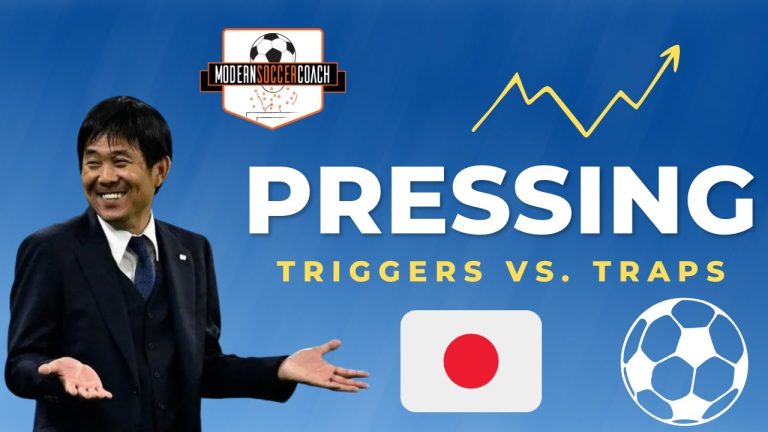Football is a game of intricate strategies, split-second decisions, and unparalleled athleticism. At its core, the sport thrives on the pressing triggers and cues that fuel its relentless intensity. From the thunderous roar of the crowd to the swift movements of players, every aspect of the game demands attention. In this article, we explore the fascinating world of these pressing triggers and cues in football, unveiling the secrets behind the game’s mesmerizing allure and captivating the hearts of fans worldwide. Get ready to delve into the captivating realm of football’s hidden signals and discover the essence of what makes this sport truly extraordinary.
What causes pressing in football?
Pressing triggers are crucial moments in a football match that ignite a team’s pressing strategy. These triggers occur when the opposition makes poor touches, allowing the pressing team to pounce on the opportunity. By capitalizing on these mistakes, the pressing team can disrupt the opposition’s play and gain control of the game.
Another common pressing trigger is when players receive the ball with their backs to their intended direction of travel. This situation puts the receiving player at a disadvantage, as they are unable to see potential threats from behind. Recognizing this vulnerability, the pressing team seizes the opportunity to apply pressure and force turnovers, creating scoring opportunities for themselves.
On the other hand, pressing traps are situations actively created by the pressing team to regain possession. By strategically positioning their players and cutting off passing lanes, the pressing team forces the opposition into making mistakes. These traps can be highly effective in disrupting the flow of the game and stifling the opposition’s attacking efforts.
In summary, pressing triggers in football are moments when the pressing team can initiate their pressing strategy, such as poor opposition touches and players receiving the ball with their backs turned. These triggers allow the pressing team to apply pressure and regain control of the game. Conversely, pressing traps are situations actively created by the pressing team to force turnovers and disrupt the opposition’s play.
What does the term trigger mean in football?
In football, a ‘trigger’ refers to the moment when a player recognizes an opportunity to gain possession. It is the cue that prompts a player to react swiftly and take advantage of a situation, such as when an opponent makes a poor first touch or an inaccurate pass. This trigger acts as a catalyst, igniting the player’s instinct to seize the chance and turn the game in their team’s favor.
What do pressing traps and pressing triggers refer to?
Pressing teams, known for their aggressive playing style, heavily rely on pressing traps and triggers to gain an advantage over their opposition. These traps and triggers can be defined as specific actions or game circumstances that inform a team’s decision to initiate their pressing tactics. From poor passes and receptions to right-footed players receiving on their left foot, passes into open spaces behind a player, and even players looking down, these pressing triggers serve as cues for the team to apply intense pressure and disrupt the opponents’ gameplay.
Uncovering the Power of Triggers and Cues: A Game-Changing Football Study
In a groundbreaking football study, researchers have unraveled the influential role that triggers and cues play in the game, revealing their game-changing power. By recognizing and understanding these subtle signals, players and coaches can gain a significant advantage on the field. Whether it’s a specific hand gesture, a verbal command, or a strategic placement of players, these triggers and cues have the ability to ignite a series of coordinated actions, ultimately leading to successful plays and victories. This study sheds light on the untapped potential of triggers and cues, proving that mastering their usage is a pivotal skill for any successful football team.
Decoding the Influence of Triggers and Cues in Football: A Thorough Examination
Decoding the Influence of Triggers and Cues in Football: A Thorough Examination
In the intricate game of football, triggers and cues play a pivotal role, dictating the actions and decisions made by players on the field. Triggers, such as a teammate’s movement or an opponent’s positioning, serve as stimuli that activate a player’s response, while cues, such as a referee’s whistle or a coach’s instruction, provide valuable information that guides players in their next move. Understanding the influence of triggers and cues is crucial for players and coaches alike, as it allows them to anticipate and react effectively to the ever-changing dynamics of the game. Through a thorough examination of these elements, we aim to shed light on the intricate mechanisms that shape football strategies and enhance players’ performance, ultimately unraveling the mysteries of this beautiful sport.
The Hidden Forces Behind Football Success: Exploring Triggers and Cues in Depth
Paragraph 1: Football success is not solely dependent on the skills and abilities of individual players or the tactical approach of the team. In fact, there are hidden forces at play that can significantly impact a team’s performance. These hidden forces, known as triggers and cues, have a profound influence on the outcome of matches. Triggers are external stimuli that activate certain behaviors, while cues are subtle signals that direct players’ attention and guide their decision-making process. By understanding and leveraging these hidden forces, teams can unlock their full potential and achieve remarkable success on the football pitch.
Paragraph 2: Triggers in football can come in various forms, such as the roar of the crowd, a certain play pattern, or even the sight of the opposing team’s jersey. These triggers can evoke specific responses in players, such as increased motivation, heightened focus, or a surge of adrenaline. Successful teams recognize these triggers and strategically use them to their advantage. For example, a team may intentionally create an electric atmosphere in their home stadium to trigger a sense of unity and excitement among their players, giving them a psychological edge over their opponents.
Paragraph 3: Cues, on the other hand, are subtle signals that provide players with crucial information to make split-second decisions on the field. These cues can be as simple as a teammate’s body language or a slight change in the opponent’s positioning. By training their players to recognize and interpret these cues effectively, teams can gain a competitive edge. Coaches play a vital role in identifying and teaching players how to respond to these cues, enabling them to make quick and accurate decisions that can turn the tide of a game. Understanding and harnessing the power of triggers and cues is a key aspect of achieving and sustaining football success.
Mastering the Art of Football: Unraveling the Impact of Triggers and Cues
Mastering the art of football requires a deep understanding of the impact that triggers and cues have on the game. Triggers, such as the sound of the referee’s whistle or the sight of an opponent’s tackle, can instantly activate a player’s response, triggering a cascade of decisions and actions. However, it is the ability to recognize and interpret these triggers, and respond accordingly, that separates the average player from the exceptional. By unraveling the intricate relationship between triggers and cues, players can anticipate and react to situations with unparalleled precision, making split-second decisions that can ultimately determine the outcome of a match.
In the fast-paced world of football, every second counts. From the deafening roar of the crowd to the adrenaline coursing through the players’ veins, the game hinges on a delicate balance of skill, strategy, and instinct. By understanding and capitalizing on the pressing triggers and cues that arise on the pitch, teams can unlock their full potential and secure victory. As players synchronize their movements, anticipate their opponents’ actions, and react in lightning-fast fashion, they create a symphony of precision and determination. In this ever-evolving sport, mastering the art of recognizing and responding to pressing triggers and cues is the key to achieving greatness on the field.



